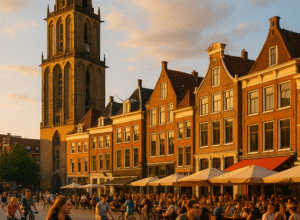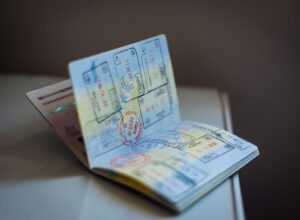Navigating the public transportation system in the Netherlands can be a breeze if you know the ropes. The Dutch are known for their efficient and reliable public transport, making it easy for both locals and visitors to get around. In this guide, I’ll walk you through everything you need to know to navigate the Dutch public transportation system like a seasoned local.
Understanding the Public Transportation System
First things first, let’s break down the different modes of public transport you’ll find here:
- Trains: The backbone of Dutch public transport, operated by NS (Dutch Railways). These trains connect cities and major towns across the country with impressive punctuality. Think of them as your high-speed gateway to the Netherlands.
- Trams: If you’re in a city like Amsterdam, The Hague, or Rotterdam, trams are your best friend. They’re super convenient for getting around urban areas. Plus, they’re a great way to see the city as you travel.
- Buses: When trams and trains won’t take you where you need to go, buses step in. They cover suburban and rural areas, making sure no destination is too remote.
- Ferries: In certain regions, ferries are the way to go. Amsterdam’s IJ River ferries are iconic, and if you’re heading to the Wadden Islands, a ferry ride is part of the adventure.
Understanding who runs what is crucial. NS (Dutch Railways) handles the national and international train routes. For regional services, you’ll come across operators like Arriva, Connexxion, and Breng. Knowing the difference can save you a lot of confusion.
OV-Chipkaart: Your Essential Travel Companion
Meet your new best friend: the OV-Chipkaart. This smart card is your ticket to ride on all public transport in the Netherlands. There are two types: personal and anonymous. Here’s a quick rundown of each:
Personal OV-Chipkaart:
- Pros:
- Can be linked to your bank account for automatic reloading.
- Offers discounts and subscriptions, such as the NS Flex.
- Personalized with your photo, so it’s secure if lost or stolen.
- Easy to manage online with detailed travel history.
- Cons:
- Requires personal information and registration.
- Costs more upfront (€7.50) and takes a few days to receive by mail.
- Not transferable to others.
Anonymous OV-Chipkaart:
- Pros:
- Can be bought and used immediately.
- Doesn’t require any personal information.
- Transferable; can be used by anyone.
- Cons:
- No option for automatic reloading.
- Doesn’t offer personalized discounts or subscriptions.
- If lost or stolen, the balance cannot be recovered.
- Limited online management options.
Where to Buy and Load an OV-Chipkaart:
You can pick up an OV-Chipkaart at train stations, supermarkets, and even online. Loading credit is just as easy. Use the machines at stations, head to a supermarket, or do it online. The OV-Chipkaart website is super user-friendly for this.
How to Use an OV-Chipkaart:
The key to using an OV-Chipkaart is to check in and out. As you enter a train, tram, or bus, tap your card on the reader. Don’t forget to check out when you leave, or you’ll be charged the maximum fare for your trip. It’s a small step, but missing it can be costly.
Planning Your Journey
When it comes to planning your journey, technology is your friend. There are a couple of apps you’ll want to download immediately:
- 9292: This app offers comprehensive route planning across all types of public transport. It’s like having a local guide in your pocket.
- NS App: Perfect for checking train schedules, delays, and real-time updates.
Understanding Schedules and Timetables:
Reading timetables might seem old school, but it’s essential. Timetables are usually posted at stops and stations, but apps give you real-time info, which is a lifesaver. Traveling during off-peak hours can also make your journey smoother and cheaper.
Tips for Seamless Transfers:
Transfers can be the trickiest part of your journey. Make sure you plan them well and allow enough time between connections. The apps I mentioned earlier are great for this, providing estimated transfer times and platform information.
Tips for Train Travel
Navigating major train stations can be overwhelming, but with a bit of know-how, you’ll breeze through them:
- Important Stations: Amsterdam Centraal, Rotterdam Centraal, Utrecht Centraal, and Den Haag Centraal are some of the major hubs. These stations are well-equipped with shops, restrooms, and dining options, so you can relax or grab a bite while you wait.
- Types of Trains: The Intercity trains are your fast lanes, connecting major cities quickly. Sprinter trains are slower, stopping at more stations, perfect for regional travel. For international travel, trains like Thalys, Eurostar, and ICE are top-notch, but remember to book in advance.
Booking and Seat Reservations:
You can buy tickets at stations, online, or via the NS app. While seat reservations aren’t usually necessary for domestic travel, they’re required for international journeys and are a good idea during peak times.
Traveling In and Out of Schiphol Airport
Schiphol Airport is one of the busiest airports in Europe, and its public transportation connections are excellent.
By Train:
The train is the fastest and most convenient way to travel between Schiphol and major Dutch cities. The Schiphol train station is located directly beneath the airport.
- To Amsterdam Centraal: Trains run frequently, taking about 15-20 minutes. Tickets can be bought at the airport or in advance via the NS app or website.
- To The Hague (Den Haag Centraal): Direct trains take approximately 30-35 minutes. Look for Intercity services for a quicker journey.
- To Rotterdam Centraal: High-speed Intercity Direct trains take around 25 minutes.
By Bus:
For destinations not directly served by trains, buses are a reliable option.
- Amsterdam Airport Express (Bus 397): Runs between Schiphol and Amsterdam city center, stopping at major points like Museumplein and Leidseplein.
- Niteliner (Bus N97): Offers service during night hours when trains are less frequent.
Taxis and Ride-Sharing:
Taxis are available outside the arrivals hall. While more expensive than public transport, they provide door-to-door service. Ride-sharing apps like Uber are also available.
Tips for Tram and Bus Travel
When it comes to trams and buses, a little etiquette goes a long way:
- Boarding and Alighting: Generally, you’ll board at the front and exit at the back. It helps keep things moving smoothly.
- Priority Seating: Always be mindful of priority seats for the elderly, disabled, and pregnant passengers. It’s common courtesy.
Finding the Right Tram or Bus:
Route numbers and destinations are clearly displayed, making it easy to find your way. In busy city centers, apps can help you find the quickest and least crowded options.
Special Considerations
Traveling with Bikes:
Bikes are a big deal in the Netherlands, and you can take them on trains, but you’ll need a separate bike ticket. Try to avoid peak hours to make your journey smoother.
Accessibility:
The Dutch are pretty good with accessibility. Most public transport is wheelchair-friendly, and you can request assistance if needed. It’s best to check routes in advance to ensure a hassle-free trip.
Traveling During Holidays and Events:
Public transport can get packed during holidays and major events like King’s Day. Plan ahead, travel early, and give yourself plenty of time to reach your destination.
Safety and Security Tips
Personal Safety:
Keep an eye on your belongings, especially in crowded places. Be aware of your surroundings to avoid pickpockets.
Emergency Procedures:
In an emergency, contact station personnel or use the emergency buttons in trains and trams. It’s also handy to know the local emergency number, 112.
Conclusion
Getting around the Netherlands is a breeze once you get the hang of it. With an OV-Chipkaart and a couple of handy apps, you’ll feel like a local in no time. Whether you’re zipping through cities on a tram or exploring the countryside by train, these tips will make your journey smooth and enjoyable.
Have any tips or experiences to share? Drop them in the comments below!








